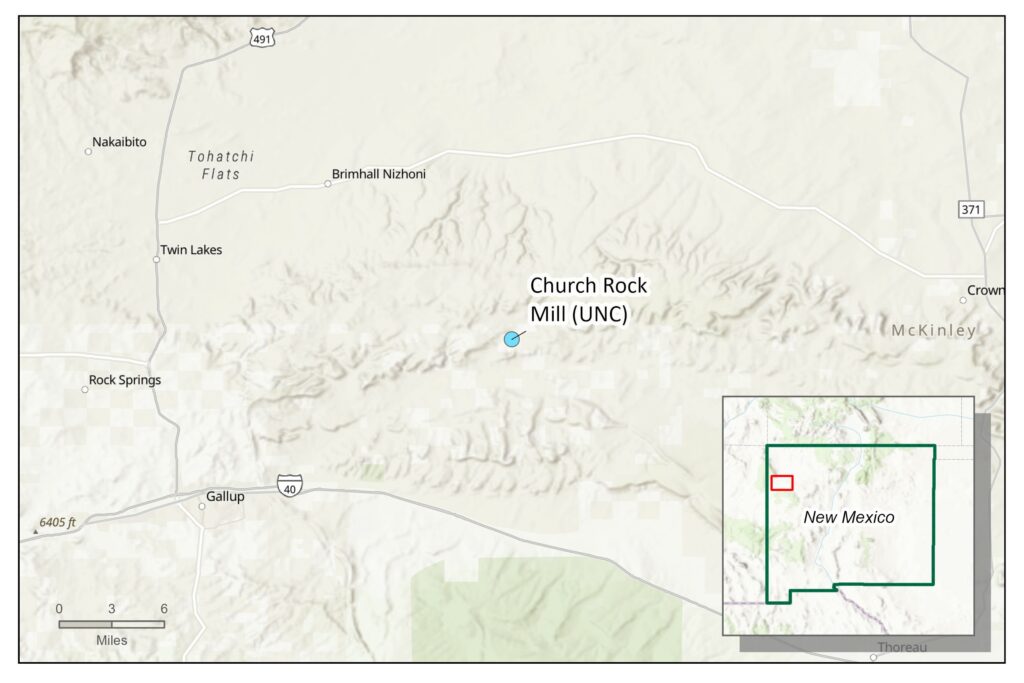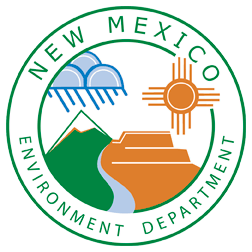Location
The United Nuclear Corporation (UNC) Church Rock Mill site is located near Church Rock, New Mexico surrounded by the Navajo Nation Indian Reservation and Tribal Allotment within the Pinedale Chapter. The site is located approximately 17 miles northeast of Gallup, New Mexico in McKinley County in the Church Rock-Crownpoint mining district.

Ownership and History
UNC owned and operated the Church Rock Mill from 1977 to 1982. The facility is currently privately owned by UNC, which is a wholly owned subsidiary of General Electric.
The mill is a licensed U.S. Nuclear Regulatory Commission (NRC) facility. It is also listed on the U.S. Environmental Protection Agency’s (EPA’s) National Priorities List as the UNC Superfund Site, EPA ID#: NMD030443303. EPA and the NRC executed a Memorandum of Understanding for the site in August 1988. The NRC Site Source Materials License No. SUA-1475 remains in effect.
Reclamation and Regulatory Jurisdiction
The mill site included an ore processing mill and tailings disposal area (TDA). UNC placed an estimated 3.5 million tons of tailings in the tailings impoundments, which are subdivided into three covered tailings contaminant cells (South Cell, Central Cell, North Cell) and two covered soil borrow pits. In 1979, a dam holding back the tailings impoundments breached, releasing 1,100 tons of uranium tailings and 94 million gallons of radioactive water into the Puerco River drainage. Beginning in 1977, acidic tailings liquids were stored in the TDA, in accordance with the NRC license and standard mill procedures at that time. Seepage from the UNC mill tailings impoundments impacted the background water (groundwater operable unit OU-01). The background water is considered the portion of the mine discharge water that had infiltrated into the subsurface during the mining era. The background water is different from the water that seeped from the tailings impoundments.
The contaminants of concern in the groundwater operable unit (OU-01) include total dissolved solids, sulfate, chloride, thorium, radium-226 and radium-228, aluminum, and iron*. The EPA-selected remedy included containing and extracting contaminated groundwater, evaporating groundwater pumped from portions of impacted aquifers (Southwest Alluvium, and Zone 1 and Zone 3 of the upper Gallup Formation) and using monitoring and evaluation programs. UNC reclaimed the cells and pits between 1989 and 1995 as the NRC directed. UNC capped the tailings cells with interim radon barriers as directed by the NRC. Two evaporation ponds were constructed on top of the cells as part of EPA’s groundwater remedy, which also includes long-term groundwater extraction and monitoring. Surface reclamation of the tailings impoundments was completed according to the NRC, except for in the South Cell, which is covered by the two evaporation ponds.
*According to the 1988 record of decision, the contaminants that would have to meet the applicable or relevant and appropriate requirements are aluminum, antimony, arsenic, barium, beryllium, cadmium, chromium, cobalt, copper, iron, lead, manganese, mercury, molybdenum, nickel, selenium, silver, thallium, vanadium, zinc, chloride, sulfate, nitrate, total dissolved solids, radium-226 and radium-228, uranium-238, thorium-230, and gross alpha particles.
Timeline for Completion of Cleanup Activities
In 2018, UNC requested an amendment to their NRC license. If approved, the amendment would permit construction of a uranium mine waste repository on the licensed mill tailings disposal area to accommodate placing the mine waste from the Northeast Church Rock Mine, referred to as the surface soil operable unit (OU-02) of the UNC Mill site. UNC would remove mine waste from the Northeast Church Rock mine site, which is located adjacent to the former mill, and transport and place the waste within the existing mill site tailings disposal area. In 2019, the NRC provided a formal acceptance letter of the amendment request. The NRC made a final licensing decision in February 2023 to permit placing the mine waste within the mill tailings disposal area. The estimated date for site closure is to be determined.
Coordination Between State and Federal Agencies
The NRC and EPA Region 6 are the primary regulatory agencies for the mill site with the state of New Mexico as EPA’s support agency. Groundwater cleanup is being implemented and monitored under EPA Superfund oversight.
The Northeast Church Rock Mine Superfund Site is under EPA Region 9. Moving the mine waste (OU-02) is a joint EPA Region 6 and Region 9 joint remedial action. Regarding the February 2023 decision to move the mine waste, the state of New Mexico had no decision-making power in the Engineering Evaluation and Cost Analysis that was released by EPA Region 9 to present various waste disposal alternatives.
Anticipated Funding Requirements
UNC is the responsible party for the site and is therefore responsible for funding remediation and cleanup activities.
Disclaimer
Site reviews in this report provide the reader with a general history and status of permitted mines and mills. For brevity, they may not provide all relevant details or agency actions related to each site.

